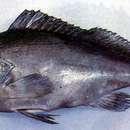Diagnostic Description
provided by Fishbase
Distinguished by the following characteristics: head, body and fins purplish grey to brownish grey; head with brown to golden brown dots and wavy longitudinal lines of the same colour on the dorsal part of the body (lines faint of absent on large specimens); narrowly blackish margin of spinous dorsal fin; body depth contained 2.7-3.1 times in SL; head length 2.5-2.7 times in SL; convex interorbital area; angular preopercle, notch above angle and enlarged serrae at angle; straight or slightly concave upper edge of operculum; subequal posterior and anterior nostrils or slightly larger posterior nostril; maxilla reaches to vertical at rear edge of eye; ventral edge of maxilla in adults with prominent knob or hook-like process; 2 rows of teeth on midlateral part of lower jaw (Ref. 89707).
Diseases and Parasites
provided by Fishbase
Bendenia Infestation. Parasitic infestations (protozoa, worms, etc.)
Morphology
provided by Fishbase
Dorsal spines (total): 11; Dorsal soft rays (total): 17 - 19; Analspines: 3; Analsoft rays: 8
Trophic Strategy
provided by Fishbase
Found on banks. Feeds on small fishes and crustaceans (stomatopods), shrimps, and pelagic tunicates (Thalia and Pyrosoma sp.
- Recorder
- Drina Sta. Iglesia
Biology
provided by Fishbase
Lives on muddy open substrate, seeking refuge in holes in the mud or with solid structures, shipwrecks or debris. A flighty species (Ref; 48635). Also found on banks (Ref. 5222). Feeds on small fishes and crustaceans (stomatopods), shrimps, and pelagic tunicates (Thalia and Pyrosoma sp.) (Ref. 5222). Solitary (Ref 90102).
- Recorder
- Estelita Emily Capuli
Importance
provided by Fishbase
fisheries: minor commercial; price category: very high; price reliability: questionable: based on ex-vessel price for species in this genus
- Recorder
- Estelita Emily Capuli
分布
provided by The Fish Database of Taiwan
分布於印度-西太平洋區,包括阿曼灣至肯亞、印度、斯里蘭卡、馬來西亞、印尼、巴布新幾內亞、菲律賓及所羅門等。台灣南部海域有產。
利用
provided by The Fish Database of Taiwan
具經濟性之食用魚。一般漁法以延繩網及底拖網捕獲。清蒸食用佳。
描述
provided by The Fish Database of Taiwan
體長橢圓形,側扁而粗壯,標準體長為體高之2.7-3.1倍。頭背部斜直;眶間區微凸。眼小,短於吻長。口大;上下頜前端具小犬齒或無,兩側齒細尖,下頜約2列。鰓耙數12-16+20-23。前鰓蓋骨後緣微具鋸齒,下緣光滑。鰓蓋骨後緣具3扁棘。體被細小櫛鱗;側線鱗孔數63-76;縱列鱗數124-150。背鰭鰭棘部與軟條部相連,無缺刻,具硬棘XI,軟條17-19;臀鰭硬棘III枚,軟條8;腹鰭腹位,末端延伸不及肛門開口;胸鰭圓形,中央之鰭條長於上下方之鰭條,且長於腹鰭,但短於後眼眶長;尾鰭圓形。頭部、體側及各鰭紫灰色至灰褐色;頭部具褐色至黃褐至小點;體側則為曲紋。
棲地
provided by The Fish Database of Taiwan
主要棲息於淺灘區。以魚類及甲殼類為食。
Epinephelus undulosus
provided by wikipedia EN
Epinephelus undulosus, the wavy-lined grouper, brown-lined reefcod, mid-water rockcod, mid-water grouper, is a species of marine ray-finned fish, a grouper from the subfamily Epinephelinae which is part of the family Serranidae, which also includes the anthias and sea basses. It has a wide Indo-Pacific distribution. They are produced through aquaculture and commercially fished.
Description
Epinephelus undulosus has a standard length which is 2.7 to 3.1 times its depth. It has a convex region between the eyes. The preopecle is angular with an incision just above its angle and there are enlarged serrations at the angle while the gill cover has a straight or slightly concave upper margin.[3] There are 11 spines and 17-19 soft rays in the dorsal fin and 3 spines and 8 rays in the anal fin.[2] The membranes between the dorsal fin spines are not notched. The caudal fin is truncate or emarginate. The ovell colour of the head, body, and fins purplish grey to brownish grey, marked with brown to golden-brown spots on the head and wavy horizontal brown or golden brown lines on the upper body, although these may be indistinct on larger fish. The margin of the spiny part of the dorsal fin has a thin line of blackish colouration.[3] This species attains a total length of 120 centimetres (47 in), although they are more commonly around 45 centimetres (18 in), and a maximum weight of 6.4 kilograms (14 lb).[2]
Distribution
Epinephelus undulosus is found in the Indian and Pacific Oceans from the coasts of Somalia and Kenya, the Gulf of Aden and Socotra east to southern India and Sri Lanka and on to the Pacific Ocean where it extends to the Solomon Islands in the east and Taiwan ion the north.[1] This species has not been recorded from the Red Sea, the Persian Gulf or Australia.[3]
Habitat and ecology
Epinephelus undulosus is found on open muddy seabeds, where it hides in holes in the mud or within solid structures, shipwrecks or debris. It is also found in banks. The adults live at depths from around 25 to 90 metres (82 to 295 ft) while juveniles may be found in water as shallow as 5 metres (16 ft) on coral reefs.[1] It is a generalist predator preying on a variety of benthic fishes and crustaceans it will also take macrozooplankton, such as pelagic tunicates of the genera Thalia and Pyrosoma, if available.[3]
Taxonomy
Epinephelus undulosus was first formally described as Bodianus undulosus in 1824 by the French naval surgeons and naturalists Jean René Constant Quoy (1790-1869) and Joseph Paul Gaimard (1793-1858) with the type locality given as Waigeo in West Papua.[4]
Utilisation
Epinephelus undulosus is fished for by fisheries off Kenya, Sri Lanka and Tamil Nadu.[3]
References
-
^ a b c Russell, B. (2018). "Epinephelus undulosus". IUCN Red List of Threatened Species. 2018: e.T132739A100562653. doi:10.2305/IUCN.UK.2018-2.RLTS.T132739A100562653.en. Retrieved 19 November 2021.
-
^ a b c Froese, Rainer; Pauly, Daniel (eds.) (2019). "Epiphenelus undulosus" in FishBase. December 2019 version.
-
^ a b c d e Heemstra, P.C. & J.E. Randall (1993). FAO Species Catalogue. Vol. 16. Groupers of the world (family Serranidae, subfamily Epinephelinae). An annotated and illustrated catalogue of the grouper, rockcod, hind, coral grouper and lyretail species known to date (PDF). FAO Fish. Synopsis. Vol. 125. FAO, Rome. pp. 250–251. ISBN 92-5-103125-8.
-
^ Eschmeyer, William N.; Fricke, Ron & van der Laan, Richard (eds.). "Bodianus undulosus". Catalog of Fishes. California Academy of Sciences. Retrieved 18 July 2020.

- license
- cc-by-sa-3.0
- copyright
- Wikipedia authors and editors
Epinephelus undulosus: Brief Summary
provided by wikipedia EN
Epinephelus undulosus, the wavy-lined grouper, brown-lined reefcod, mid-water rockcod, mid-water grouper, is a species of marine ray-finned fish, a grouper from the subfamily Epinephelinae which is part of the family Serranidae, which also includes the anthias and sea basses. It has a wide Indo-Pacific distribution. They are produced through aquaculture and commercially fished.
- license
- cc-by-sa-3.0
- copyright
- Wikipedia authors and editors

